| 
Ultra-Microcruisers with an Attitude
STASIS7
First design for trans-oceanic smallness
design by Chris Ostlind
It must have been about a month ago when yet another round of size oriented boat talk came whistling through one of the Yahoo Groups. Only this time it wasn’t the typical penchant that boaters have for “Gotta Get Me a Bigger Boat” cause a bigger boat sends a real message to the other guys out there when they see me tied-up to the dock.
Nope, this time it was all about how small can you get it and still cross an ocean. Personally, I find this process to be right out of the tales of Marquis deSade, as only a true masochist would fold himself into one of these ridiculous compartments and call it comfortable for anything more than a Photo Op.
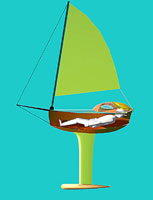 Click images for larger views
Click images for larger views |
Nevertheless, there it was, the announcement that someone was going to not only build one of these claustrophobia generators, but they were also going to do a booklet on the construction of same… and have the audacity to charge for said, copyrighted booklet.
Dr. Phil couldn’t have suited-up a better guest for his show than this.
So there I sat in my studio, wondering just what went into the decision making process that would lure an apparently sane person into the interior of what amounts to a floating sleeping bag for a trans-oceanic thrash into some level of personal stardom.
Hmmmmm, the mind can truly do some weird things when it gets onto a roll of such obscure strategies.
OK, I’ll just admit it up front. The weirdness of it all had me hooked and so I set off to design a pair of really small boats for tooling off into the sunrise after leaving the safety of Newfoundland. Great Britain, here I come, though not without my own philosophical baggage along with a whole host of ethical questions regarding ocean crossing behaviors. This is the first of the two designs.
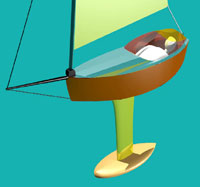 Stasis7
Stasis7 |
While the current record for the smallest boat to sail across an ocean is held by the 5’4” Father’s Day sailed by Hugo Vihlen, I wasn’t really going for the record with my first design. Instead, I wanted scientific novelty and the undying adoration of the pharmaceutical and medical community. I also wanted to take the tiny boat community and functionally poke it in the eye…. repeatedly.
I believe that my design for the boat I call Stasis7 does that and more.
The big issues aboard such a small boat are, naturally where to store the necessary food and water as well as how to keep the crew safe in nasty conditions. Stasis7 addresses those concerns with a novel set of solutions that virtually guarantee a healthy and rested crew upon arrival in Great Britain.
The boat is a mere 7’ in length overall with a beam of just 32”. Stasis sports a sail of just under 30 sq. ft. The sail mounts to an aft pivoting step right at the stem with a small bowsprit projecting forward from nearly the same position. The sail is fixed to the mast and the mast rotates to reef the sail. In a big blow the mast not only rotates to stow the sail but it lays flat on the deck.
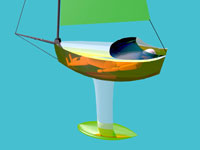 All sail controls are automated from a central microprocessor that takes input from wind speed and direction, barometric pressure, sea state differential potentiometers, G-force sensors and GPS. The sensor output is collected and fed through the processor where it is compared to hundreds of different sailing and sea state scenarios to predict conditions, as well as derive the proper settings of sail trim and deployed surface presented to the wind. In short, all sailing controls are automated for the occupant. All sail controls are automated from a central microprocessor that takes input from wind speed and direction, barometric pressure, sea state differential potentiometers, G-force sensors and GPS. The sensor output is collected and fed through the processor where it is compared to hundreds of different sailing and sea state scenarios to predict conditions, as well as derive the proper settings of sail trim and deployed surface presented to the wind. In short, all sailing controls are automated for the occupant.
At the core of the success of the boat is it’s fantastic ultimate stability which is derived from a long keel appendage and terminal, weighted bulb that is cast in one piece, guaranteeing that the bulb will not fall off, destabilizing the boat while under way.
The long, fin appendage also houses all the necessary life support equipment for the journey, thus freeing-up the cabin space in the main hull for the crew’s comfort. Crew comfort in this case, is perhaps a misnomer of sorts, as it is not derived in the normal sense of the descriptive usually associated with boating activities.
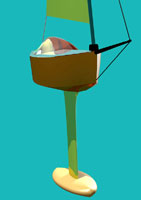 The solo crew of Stasis7 will cross the Atlantic in a drug-induced state of suspended animation. The solo crew of Stasis7 will cross the Atlantic in a drug-induced state of suspended animation.
To truly free the occupant from most of the needs of the typical metabolizing human, they will be hooked-up to an I.V. drip for the entire journey. The IV solution will provide the minimum amounts of saline, sucrose and necessary salts to maintain proper metabolic conditions while under the influence of the proprietary Stasis7 cocktail that is included in the solution.
The crew will wear a special suit that will recycle all fluid perspiration and return it to the filtering system where it will be made available for re-introduction to the IV process. The same will apply to all urine, as it will be collected via catheter for the same, recycling process.
With metabolic rates reduced to less than 10% of the normal, resting condition, supplemental needs will be reduced to near zero beyond those provided in the IV.
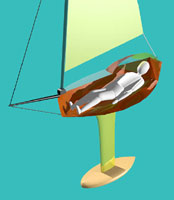 Mild brain stimulation will be provided through a special skullcap that will massage the electric capacity of the brain to keep the synapses firing at a very low ebb. This will ensure that the crew can come back out of the Stasis process as the craft nears the shores of England. Mild brain stimulation will be provided through a special skullcap that will massage the electric capacity of the brain to keep the synapses firing at a very low ebb. This will ensure that the crew can come back out of the Stasis process as the craft nears the shores of England.
Since this boat is designed to take a small advantage from the prevailing winds during the journey, it is primarily a drifting vehicle that will enjoy the gifts of the Gulf Stream for most of the trip.
It’s a simple boat, really. A comfortably padded interior with soft, NASA memory foam throughout. A smart glass, Lexan, canopy that darkens in bright light and returns to a nearly clear state in the night, will regulate lighting.
So, there it is; the no-brainer method to cross an ocean in the smallest of boats with minimal hassle for the occupant. At thirty miles off the English Coast, the GPS triggers an automatic injection into the IV solution of a pleasant chemical cocktail that brings the crew back to a normal state. This process allows them to steer the Stasis7 into the nearest harbor for a pre-placed meal, designed to jump-start their GI tract without any rude surprises.
 I figure 2 months and some change to get across the Atlantic. I figure 2 months and some change to get across the Atlantic.
Chris Ostlind
Lunada Design

Next Month: The Oceanic Pencil
|

